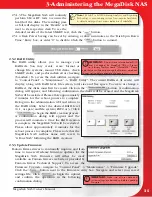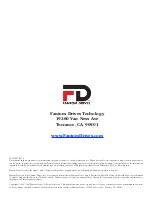
Megadisk NAS Owner’s Manual
34
Appendix B: Glossary
ATA
Acronym for “
AT
Bus
A
ttachment” - a standard interface to IDE hard disks. Western Digital’s
IDE disk interface was standardized by ANSI to form the ATA specification using a 16-bit ISA bus.
Cache
a fast-access memory bank that serves as an intermediate storage for data that is read from
or written to secondary storage. Typically, high-speed caches are implemented in RAM, though
they can also be implemented on disk when speed is not a critical requirement. Caches generally
improve the efficiency of read operations due to the principles of “spatial and temporal locality
of data”. They can also improve the efficiency of write operations.
Common Internet File System (CIFS)
a network protocol for sharing files, printers, serial ports,
and other communications between computers. CIFS is based on the widely-used SMB protocol.
Degraded Mode/Status
All arrays, with the exception of
RAID
0, are designed to handle disk
failures. However, there is limit on the number of hard disks that can fail before the array is
rendered inoperative. For instance, this limit value is 1 for
RAID
1, 3, and 5. In the case of
RAID
10 or 50, the upper bound is equal to the number of parity groups. When the number of disk
failures occurring in an array are less than or equal to this upper bound, the array is denoted to
be in a degraded state. The failure of the disks does not impair reading from or writing to the
array. However, it impairs the efficiency of throughput in all RAID types (with the exception of
RAID 1) since data requested by read operations may have to be “reconstructed” using parity. In
the case of RAID 1 the throughput of read operations is cut in half if a drive fails. Operating in
degraded mode is considered an acceptable alternative only for short durations. Generally this
duration should span no more time than that required to inform the user of the failures and to
replace the failed disks with suitable spares.
Device Driver
A piece of software that controls a hardware device. Typically drivers provide an
interface by which applications can use the device in a uniform and hardware-independent manner.
Dirty Data
Dirty data is data that has been written to a cache but has not been “flushed,” or
written to its final destination, typically some secondary storage device.
Disk Array
A Disk Array is a logical disk comprised of multiple physical hard disks. The number of
hard disks in an disk array is dictated by the type of the array and the number of spares that may
be assigned to it. Furthermore, whether a disk array can be built using part of the space on a disk
(as opposed to being forced to use the whole disk) depends upon the implementation. Disk Arrays
are typically used to provide data redundancy and/or enhanced I/O performance.
Disk Block
Data is stored on disks in blocks that are generally of a predefined size. This size
is typically a value such as 512 bytes, 1 KB, 2 KB, etc. When a record is written to a disk, the
blocks used for that record are dedicated to storing the data for that record only. In other words
two records are not permitted to share a block. Consequently, a block may be only partially used.
For instance, assume a disk has a block size of 1 KB and a user record written to it has a size of
3148 bytes. This implies that the user record will be written into 4 blocks, with the contents of
one of the blocks being only partially filled with (3148 – 3072) 76 bytes of data.
B-Glossary






































